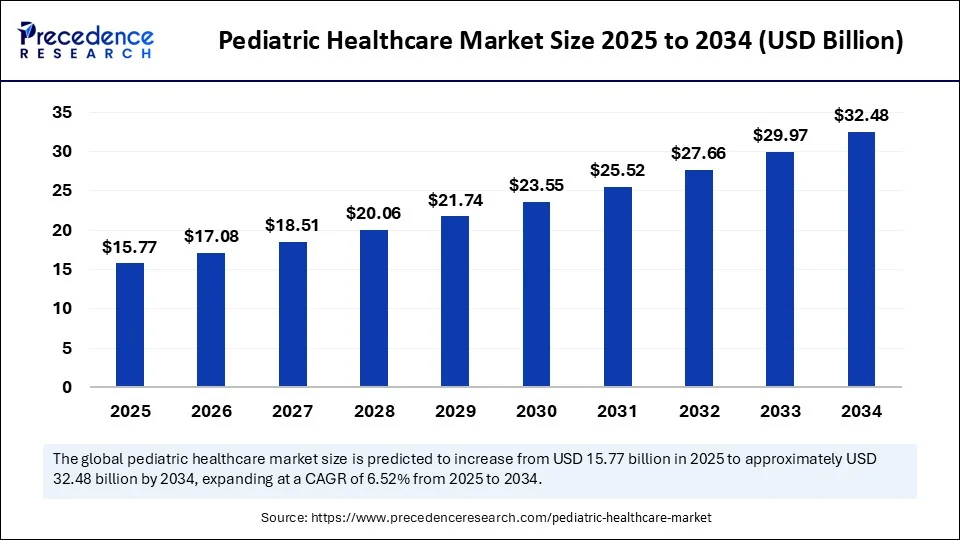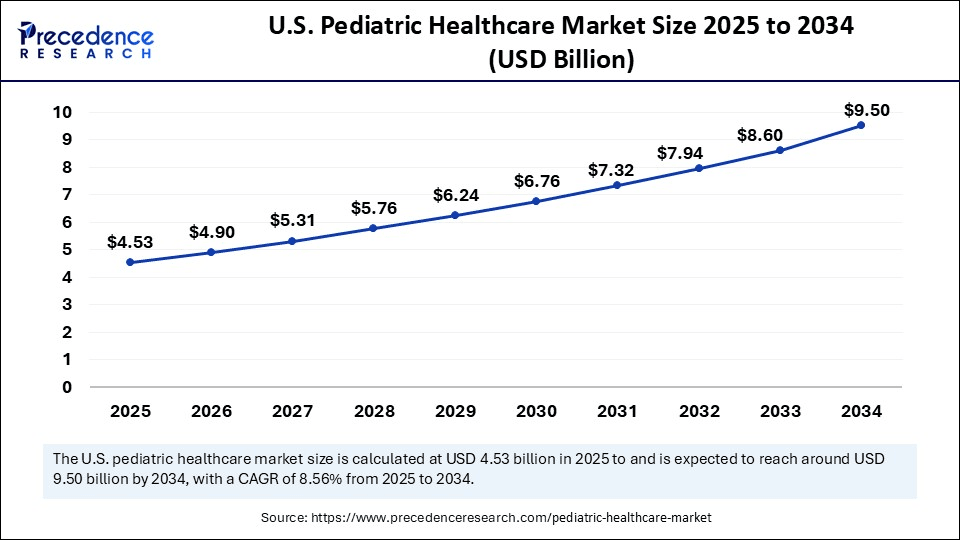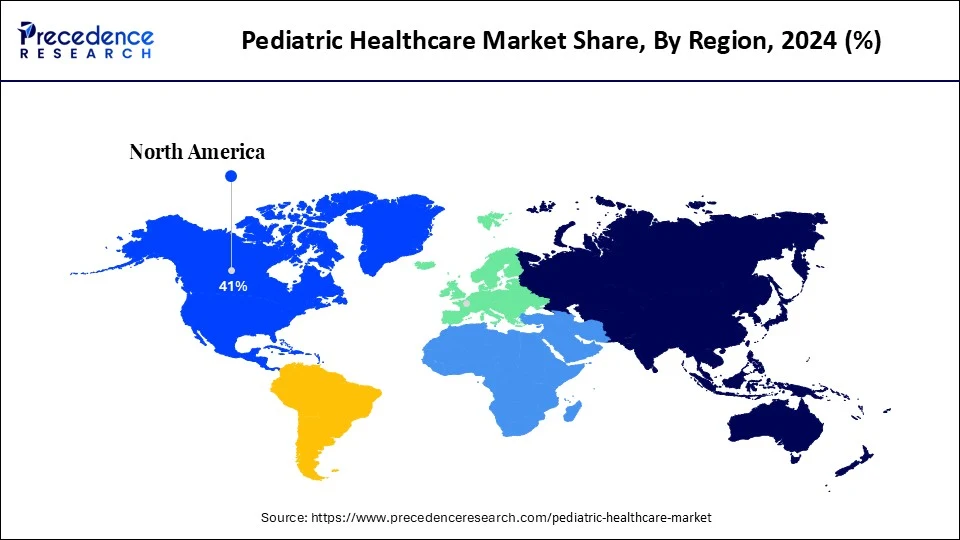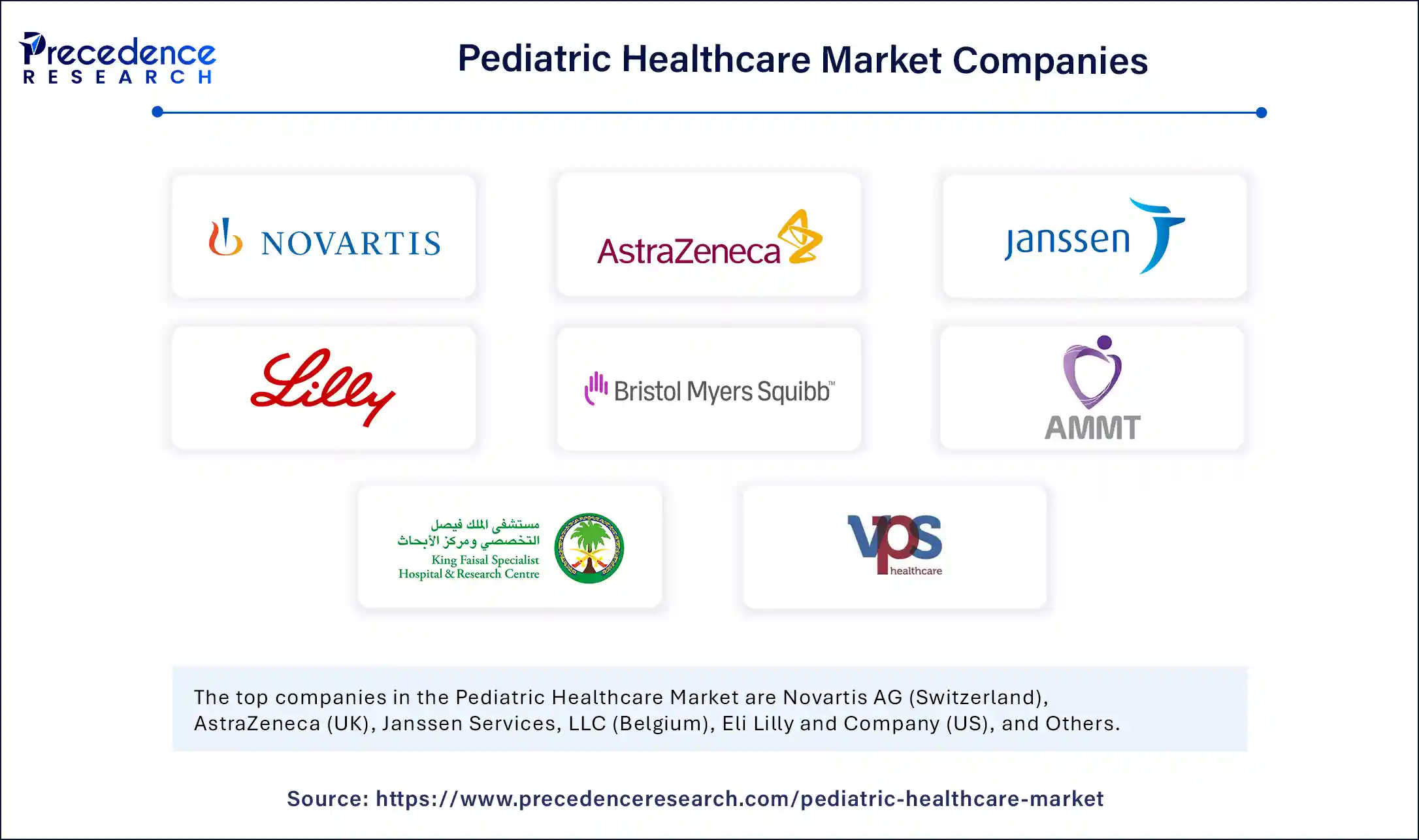List of Contents
Pediatric Healthcare Market Size and Forecast 2025 to 2034
The global pediatric healthcare market size accounted for USD 14.55 billion in 2024 and is predicted to increase from USD 15.77 billion in 2025 to approximately USD 32.48 billion by 2034, expanding at a CAGR of 6.52% from 2025 to 2034. The pediatric healthcare market is expanding due to rising childhood disease prevalence, increasing demand for specialized treatment, and advances in medical technology leading to strong growth along with access to quality care for children around the globe.

Pediatric Healthcare Market Key Takeaways
- The global pediatric healthcare market was valued at USD 14.55 billion in 2024.
- It is projected to reach USD 32.48 billion by 2034.
- The market is expected to grow at a CAGR of 6.52% from 2025 to 2034.
- North America dominated pediatric healthcare market with the highest share of 41% in 2024.
- Asia Pacific is estimated to expand the fastest CAGR in the market between 2025 and 2034.
- By type of disease, the short term diseases segment held the largest market share in 2024.
- By type of disease, the chronic diseases segment is anticipated to grow at a remarkable CAGR between 2025 and 2034.
- By therapeutics, the infectious disease segment captured the biggest market share in 2024.
- By therapeutics, the allergy and immunology segment is expected to expand at a notable CAGR over the projected period.
- By treatment, the Medication segment contributed the major market share in 2024.
- By treatment, the Surgery segment is expected to expand at a notable CAGR over the projected period.
Artificial Intelligence Transforming Pediatric Healthcare Globally
Artificial Intelligence (AI) is changing pediatric health care by improving diagnostic accuracy, customizing treatment plans, and improving clinical workflows. Many AI tools are starting to be integrated into pediatric radiology, and this will improve early identification of congenital heart defects, neurological problems, and rare genetic diseases with improved accuracy and speed. In 2024, Boston Children’s Hospital expanded its AI-based clinical decision support systems into its pediatric ICU, and found a significant decrease in time from diagnosis to response in urgent matters.
AI can also assist health care providers with predictive analytics to identify high risk pediatric patients. This allows for timely intervention and improved outcomes for a patient. Natural Language Processing (NLP) is being used to gather insights from pediatric patient medical records to improve documentation, improve their research capacity, and transfer information to the next provider. In large geographical area, AI-powered telepediatrics is being used to bridge access to care with timely virtual care and virtual follow-up visits. As pediatric data continues to grow and AI models become more sophisticated, AI models will help to drive new models of child-centered health care around the world.
- In January 2025, Genrobotics, a leading robotics company, launched India's first robotic-assisted Paediatric Gait Trainer, G-Gaiter Paediatric. It aims to improve physical rehabilitation for children with mobility issues. The device uses advanced VR technology and interactive games for therapy.
(Source: https://www.genroboticsmedical.com)
U.S. Pediatric Healthcare Market Size and Growth 2025 to 2034
The U.S. pediatric healthcare market size was exhibited at USD 4.18 billion in 2024 and is projected to be worth around USD 9.50 billion by 2034, growing at a CAGR of 8.56% from 2025 to 2034.

Why North America is dominating the Lead in the Pediatric Healthcare Market?
North America continues to be the leading region for the pediatric healthcare market, attributed to its developed medical system, universal coverage, and substantial government-backed health initiatives. In the United States, the Centers for Disease Control and Prevention (CDC) and the Vaccines for Children (VFC) program provide many children with necessary immunizations, reducing the overall burden of disease. Almost 97% of U.S. children have access to routine healthcare providers, allowing early detection and interventions. The CDC rolled out additional tools for preventing RSV, including monoclonal antibodies for infants and vaccines for mothers. CDC statistic reports the decline in rates of infant mortality.
U.S. Pediatric Healthcare Market Trends
The U.S. continues to be a central player in North America’s pediatric care ecosystem. Recent CDC reports documented how priorities in immunization are changing the outcomes of children. In 2024, there were spikes in pediatric flu deaths that resulted from the significant decrease in flu vaccine uptake. Public awareness drives were launched nationwide. Digital health, school-based programs, and Medicaid expansion continue to add to children’s access to care and overall quality of care. Although still funded primarily through state budgets, many states are also raising the volume of investments in their pediatric systems to address the growing behavioral health issues in children.
- In January 2024, oGabi SmartCare today announced the FDA certification of its digital pediatric solutions. The Belgian medtech start-up will launch the marketing of its connected bracelet specially designed for children aged 0 to 12 and its digital platform in the 2nd quarter of 2024 in the United States.
(Source: https://www.businesswire.com)

Why is Europe the Second leading Region in this Market?
Europe has grown into the second largest region in the world for pediatric healthcare, as evidenced by the healthcare systems with strong public service examples, equitable insurance for populace, and collaborative frameworks addressing issues of children’s health. In April, WHO- Europe, along with UNICEF, launched a refreshed child and adolescent health strategy for the region to resolve challenges including increasing obesity, mental health disorders and developmental delay. WHO- Europe estimates that one out of three children in the region are overweight, and one in four children have mental health problems, which has made early action and a wide range of inclusive pediatric services a priority for many governments. The region has also focused on preventive care for children, ongoing developmental checks, and children having access to care at a community level.
The UK continues to influence pediatric care in the European region with its National Health Service (NHS). The NHS provides free universal access to child health services, and has recently enhanced developmental checks and mental health checks in primary care. The UK also leads on national immunization programs, digital health records for children, and early learning programs. The UK has benefited from being aligned to UNICEF and WHO frameworks, and is working to mitigate inequities for areas and communities that experience disadvantages in health access. These coordinated efforts continue to ensure that the UK has a robust leadership role in pediatric healthcare.
Asia Pacific Pediatric Healthcare Market Trends
The Asia Pacific region is the fastest growing segment in the pediatric health care market with increasing birth rates, increasing health care delivery systems, and strategic government policies. India and China are spending billions of dollars developing pediatric and maternal care and are putting together widespread immunization and digital health systems. The research component of the Asia Pacific Pediatric Association has increased collaboration across borders and will launch a regional journal in 2025 focusing on child health research and better shared medical practices. Policy planning and resource expenditure efforts are focused on preventive health interventions, immunization programs and maternal-child health integration in early childhood interventions and health programming focusing on disease burden reduction and child development efforts specifically in rural as well as urban health systems.
India is making significant progress in pediatric health care through improved immunization and infrastructure programs. In September 2024, Indian Immunologicals Limited launched a made-in-India Hepatitis A vaccine for children—a significant milestone in the fight against a highly contagious liver infection that affects young children in most cases. This progression strengthens the country's preventive care system and complements larger national efforts to lessen the infectious disease burden. Continued work on digital health initiatives and government-sponsored pediatric hospitals will help sustain India's leadership position for pediatric progress in the Asia Pacific.
(Source: https://www.expresspharma.in)
Market Overview
The pediatric healthcare market includes medical services, treatments, and products created specifically to treat infants, children, and adolescents (under 18). The pediatric healthcare market includes pediatric diagnostic, therapeutics, surgical care, and preventative care through hospitals, clinics, and home locations.
This market is changing quickly due to growing focus on the health of children, the increasing prevalence of chronic childhood conditions such as asthma, obesity, diabetes and other chronic diseases, and expansion of pediatric and neonatal intensive care services. Advancements in technology (for example pediatric imaging, telehealth, and drug formulations designed for children) are also contributing to changing treatment outcomes. In addition, government initiatives and health organizations are promoting and sponsoring immunization and nutrition exclusively designated for children that are very rapidly building the pediatric care infrastructure expectantly. Increasing healthcare spending and more access and efficiencies in accessing specialized care (such as pediatrics) create a large, steady expansion trajectory for the pediatric healthcare market in developed and developing economies.
What are the main growth trends driving the microwave ablation devices market?
- Increased Chronic Diseases in Children: The increase in pediatric diseases, such as asthma, diabetes, and obesity, is causing a significant increase in demand for specialized diagnostics, treatments, and long-term therapeutic solutions to treat children.
- Advancements of Pediatric Technologies: Technologically advanced approaches to imaging diagnostic methodologies, minimally invasive surgical techniques, and pediatric drug delivery options are positively impacting diagnosis and outcomes, and making child-centered healthcare more effective.
- Government Health Initiatives: Public health campaigns on immunization, nutrition, and early intervention are calling attention to public health that represents pediatric care and also broadening access to medical services and health services that are relevant and essential across regions.
- Increasing Pediatric Population: Globally rising birth rates, especially in developing countries, are keeping pediatric patients at the forefront of patient-based demographics, intensifying care requirements and affecting the patient population as a whole.
- Growth of Telepediatrics: Telehealth platforms are extending the healthcare experience for pediatric patients in remote and rural locations, with the ability to increase accessibility, timely consultations, and continuous monitoring that places less of a demand on physical healthcare facilities.
Market Scope
| Report Coverage | Details |
| Market Size by 2034 | USD 32.48 Billion |
| Market Size in 2025 | USD 15.77 Billion |
| Market Size in 2024 | USD 14.55 Billion |
| Market Growth Rate from 2025 to 2034 | CAGR of 6.52% |
| Dominating Region | North America |
| Fastest Growing Region | Asia Pacific |
| Base Year | 2024 |
| Forecast Period | 2025 to 2034 |
| Segments Covered | Type of Diseases, Therapeutics, Treatment, and Region |
| Regions Covered | North America, Europe, Asia-Pacific, Latin America, and Middle East & Africa |
Market Dynamics
Drivers
Rise in Chronic Child Conditions Requires Ongoing Availability of Medical Care
Among the biggest growth factors in pediatric health care are the rise in chronic diseases in children. Recently, there has been a rise in childhood obesity, asthma, diabetes type 1 and 2, and neurodevelopmental disorders like ADHD and autism in children around the globe and in developed and developing countries. Over 40% of the roughly 73 million children (aged 0-17) in the United States have at least one chronic health condition, according to the CDC, such as asthma, allergies, obesity, autoimmune diseases, or behavioral disorders. (https://www.whitehouse.gov/wp-content/uploads/2025/05/WH-The-MAHA-Report-Assessment.pdf) There are similar alarming rises in pediatric diabetes and child respiratory illnesses in India, Brazil, and a host of other countries that are dealing with pollution and associated lifestyle changes.
Chronic health conditions require ongoing diagnosis, management, and treatment plans with routine follow-up appointments, treatment decisions, and/or input from different specialists. There has been a rise in demand for pediatric endocrinologists, pulmonologists, and developmental specialists which are implementationg pediatric subunits and pediatric specific technology into their hospital infrastructure. Consequently, the ongoing, chronic condition need for health care infrastructures are developing pediatric-specific treatment options, infrastructures, pharmaceuticals, and digital health technologies that want to create pediatric health-centric solutions.
Restraint
High costs and inadequate accessibility limit the reach of the market
The pediatric healthcare marketplace is developing rapidly, however, it faces restraint caused by high costs of treatment and unequal access to specialized pediatric care. Pediatric treatments tend to have child-specific drugs, custom devices, and professional practitioners providing that care, and these increase the cost of pediatric healthcare service.
In March 2024, regional health agencies in South Korea, announced severe shortage of paediatricians. Also South Korea's government allocated $987 million (1.3 trillion won) over five years to enhance pediatric care and reduce hospitalization costs for children under two.( https://koreapro.org/2024/03/south-korea-pledges-significant-boost-for-pediatric-care-amid-doctor-shortage/) Parents in rural areas were compelled to travel hundreds of kilometers for very basic neonatal or emergency care, and this situation shows how cost and access can emerge as a serious travel factor for both children and parents, even in a first-world country. In developing areas, such as sub-Saharan Africa, UNISEF reported that up to 59% of children lacked access to minimum pediatric diagnostic services because of a lack of funding and infrastructure. These financial and logistical impediments slow access to timely intervention, curtailed equitable access to care pathways, and overall subverted market ability to grow across all socio-economic status groups.
Opportunity
Expansion of Digital Health Initiatives Generates New Opportunities in Pediatric Care
The rapid growth of digital health technologies specifically for children is a key opportunity in the pediatric healthcare market is. Following the pandemic all patients have become more accustomed to telemedicine, leading to an increase in demand for virtual pediatric consultations and monitoring from home. In 2025, the American Academy of Pediatrics recommended expanded use of telehealth for chronic pediatric conditions such as diabetes and asthma as these patients have been shown to have better adherence to their health care plans and increased access to care in rural settings.
Digital health technologies such as wearable health devices and artificial intelligence (AI) health apps for children are also on the rise due to the vast amounts of real-time health data generated to be utilized by caregivers and doctors. Digital pediatric health platforms are now being funded by governments in regions like Europe and Asia to improve early diagnosis and continuous care. This movement is creating valuable opportunities for device manufacturers and tech driven pediatric service providers in developed as well as emerging markets.
Type of Diseases Insights
Why Do Short Term Diseases Dominate Pediatric Medicine?
Short term diseases dominates the market in 2024, diseases such as flu, cold, respiratory diseases and ear diseases, are a big part of pediatric medicine. There is a high prevalence of these types of diseases due to the child's unstable immune system, and active exposure in a contagious environment at home and in daycare/school settings. Children who visit for these diseases frequently have connected numbers of outpatient visits, over-the-counter treatments, and short-term treatment plans in the pediatric practice. The growing parental awareness and short-term treatment possibilities are a factor in the short term disease prominence globally.
Chronic pediatric diseases such as juvenile diabetes, asthma, epilepsy, congenital heart diseases are a growing reality for pediatrics globally due to environmental changes, hereditary traits, and technology with increasing measurement quality. The beefed-up processes of early detection monitoring and long-term care require an increase in healthcare service development and delivery to facilitate pediatric care planning. With wearable monitoring devices, AI, computerized diagnosis, and telehealth, there is increased application and development in this segment of pediatric medicine. Since most chronic pediatric diseases project long-term treatment plans, technology continued education and increased facility expectations are increasingly leaving a growing long-term connection with patients, making this the fastest-growing area in pediatric health care.
Therapeutic Insights
Which Therapeutic Condition Dominated the Pediatric Healthcare Market in 2024?
Infectious disease dominates the pediatric healthcare market in 2024. The most commonly treated class of therapy in pediatrics because children frequently present with viral and bacterial infections. Conditions such as pneumonia, tuberculosis, and diarrhea are still significant health threats, particularly in developing countries. Immunizations, antibiotics, and antivirals continue to dominate pediatric prescriptions, with government vaccination programs boosting the total treatment volume. Hospitals and clinics continue to provide management for these therapies because they are robustly preventable and manageable, creating constant demand for the medications.
Allergy and immunology therapies are expanding quickly because more children are being diagnosed with food allergies, eczema, asthma, and other autoimmune diseases. Awareness is rising, diagnostic routes are broadly available with methods such as multiple medical and blood laboratory tests, and there is growing demand for individualized, personalized immunotherapies with each child being treated differently. New pediatric allergy clinics and the introduction of biologic drugs and lifestyle/actual approaches to treating and managing diseases contribute to care delivery. This area is also supported by the increase in research and development into immune-modulating therapies uniquely developed for children.
Treatment Insigts
What Makes Medications the Dominating Treatment Type?
Medications segment is the most dominating treatment type in pediatric healthcare, since most pediatric conditions, regardless of whether they are acute or chronic, are handled first with medication. The use of antibiotics, antivirals, antipyretics, and medications like insulin and anti-asthmatics is well established. Additionally, the availability of and acceptance of specific pediatric dosing formulations for medications (syrups, chewables, pills that dissolve/melt in your mouth) supports this. Pediatric knowledge of safer medications, rapid expansion of available medications, and a high response to therapeutic interventions from very young children, parents, and clinicians contribute to the acceptance of drug-based treatment paths.
Pediatric surgery has taken off due to a rise in diagnoses of congenital anomalies, cancer in children, and orthopedic conditions. Parents and clinicians are less hesitant to consider surgery, as safer and better surgical means, including minimally invasive surgery, has expanded. Pediatric surgery, at specialty centers, and the expansion of robotic-assisted options are expanding the field. Conditions such as cleft palate, congenital heart defects, and hernias require more urgent surgical care, and pediatric surgery is being offered at the moment at more specialized hospitals and as distinct pediatric surgical specialties.
Pediatric Healthcare Market Companies

- Novartis AG (Switzerland)
- AstraZeneca (UK)
- Janssen Services
- LLC (Belgium)
- Eli Lilly and Company (US)
- Bristol-Myers Squibb Company (US)
- AMMT (Dubai)
- King Faisal Specialist Hospital and Research Centre (Saudi Arabia)
- VPS Healthcare (UAE)
- Others
Recent Developments
- In June 2025, CallMyDoctor.ae, a leading home healthcare provider in Dubai, launched its “Pediatrician at Home Dubai” service, a round-the-clock pediatric care solution delivered at the patient’s home. This innovative service deploys Dubai Health Authority (DHA)-certified pediatricians to households 24/7, ensuring that children receive prompt, professional medical care without the stress of clinic visits.
(Source: https://fox59.com)
- In March 2025, The Icahn School of Medicine at Mount Sinai has launched the Center for Artificial Intelligence (AI) in Children’s Health, the first dedicated center of its kind in New York City. It is a pioneering initiative that aims to improve health care outcomes for children using AI.
(Source: https://www.mountsinai.org)
Segments Covered in the Report
By Type of Diseases
- Short Term Diseases
- Chronic Diseases
- Others
By Therapeutics
- Cardiology
- Allergy and Immunology
- Gastroenterology
- Infectious Disease
- Others
By Treatment
- Medication- Dominating
- Surgery- Fastest Growing
- Others
By Region
- North America
- Europe
- Asia-Pacific
- Latin America
- Middle East and Africa
For inquiries regarding discounts, bulk purchases, or customization requests, please contact us at sales@precedenceresearch.com
Frequently Asked Questions
Ask For Sample
No cookie-cutter, only authentic analysis – take the 1st step to become a Precedence Research client